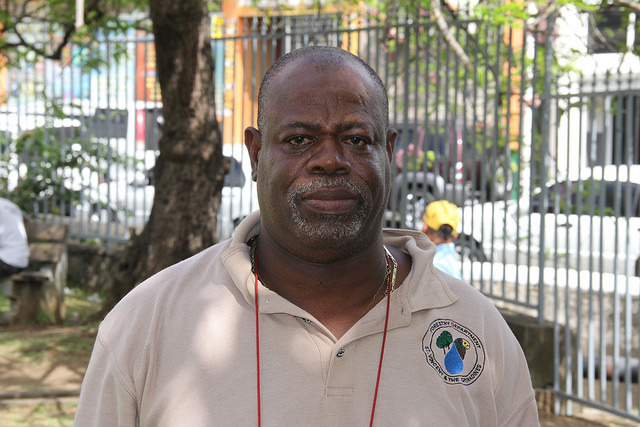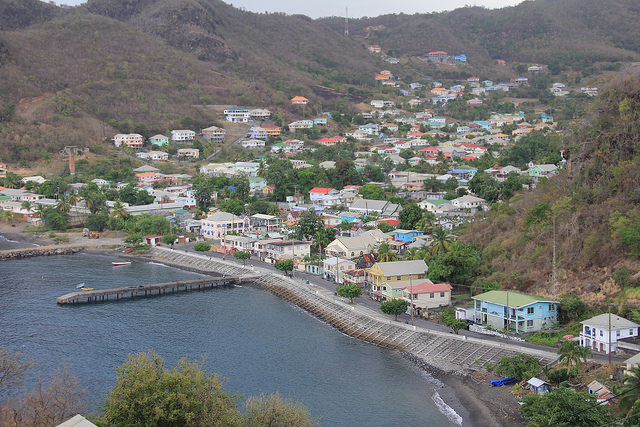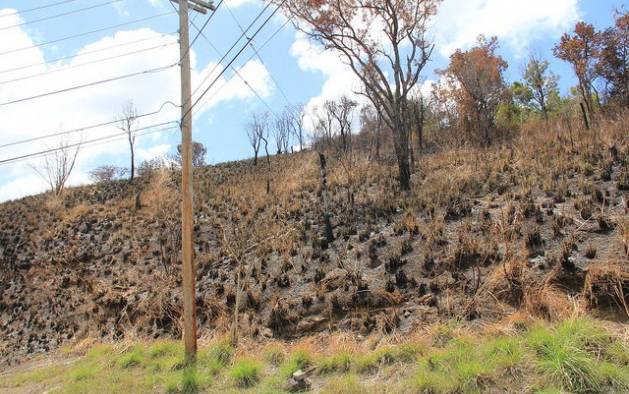By Kenton X. Chance
For 32 years, Joel Poyer, a forest technician, has been tending to the forest of St. Vincent and the Grenadines.
His job allows him a unique view of what is taking place in the interior of this volcanic east Caribbean nation, where the landscape mostly alternates between deep gorges and high mountains.
Poyer, a 54-year-old social and political activist and trade unionist, is hoping that during the 18 months before he retires, he can get the government and people of St. Vincent and the Grenadines to focus on how human activities on the nation’s beaches and in its forests are exacerbating the impacts of climate change.
“Right now, it’s like a cancer eating [us] from the inside,” he tells IPS of the actions of persons, many of them illegal marijuana growers, who clear large swaths of land for farming — then abandon them after a few years and start the cycle again.
Over the past few years, extreme weather events have shown the people of St. Vincent and the Grenadines how activities happening out of sight in the forest can have a devastating impact on coastal and other residential areas.
Three extreme weather events since 2010 have left total losses and damage of 222 million dollars, about 60 per cent of the country’s gross domestic product.
In October 2010, Hurricane Tomas left 24 million dollars in damage, including damage to 1,200 homes that sent scores of persons into emergency shelters.
The hurricane also devastated many farms, including the destruction of 98 per cent of the nation’s banana and plantain trees, cash crops for many families.
In April 2011, heavy rains resulted in landslides and caused rivers to overflow their banks and damaged some 60 houses in Georgetown on St. Vincent’s northeastern coast.
In addition to the fact that the extreme weather event occurred during the traditional dry season and left 32 million dollars worth of damage, Vincentians were surprised by the number of logs that the raging waters deposited into the town.

On Dec. 24, 2013, unseasonal heavy rains triggered landslides and floods, resulting in 122 million dollars in damage and loss.
Again, residents were surprised by the number of logs that floodwaters had deposited into towns and villages and the ways in which these logs became battering rams, damaging or destroying houses and public infrastructure.
Not many of the trees, however, were freshly uprooted. They were either dry whole tree trunks or neatly cut logs.
“We have to pay attention to what is happening in the forest,” Prime Minister Ralph Gonsalves told the media after the extreme weather event of December 2013.
“If we are seeing these logs in the lower end, you can imagine the damage in the upper end,” he said, adding that the Christmas Eve floods had damaged about 10 per cent of the nation’s forest.
“And if those logs are not cleared, and if we don’t deal properly with the river defences in the upper areas of the river, we have a time bomb, a ticking time bomb, because when the rains come again heavily, they will simply wash down what is in the pipeline, so to speak, in addition to new material that is to come,” Gonsalves said.
Almost one and a half years after the Christmas disaster, Gonsalves tells IPS a lot of clearing has been taking place in the forest.
“And I’ll tell you, the job which is required to be done is immense,” he says, adding that there is also a challenge of persons dumping garbage into rivers and streams, although the government collects garbage in every community across the country.
The scope of deforestation in St. Vincent and the Grenadines is extensive. In some instances, persons clear up to 10 acres of forest for marijuana cultivation at elevations of over 3,000 feet above sea level, Poyer tells IPS.
“Some of them may cultivate using a method that is compatible, whereby they may leave trees in strategic areas to help to hold the soil together and attract rain. Other will just clear everything, as much as five to ten acres at one time for marijuana,” he explains.
But farmers growing legal produce, such as vegetables and root crops, also use practices that make the soils more susceptible to erosion at a time when the nation is witnessing longer, drier periods and shorter spells of more intense rainfall.
Many farmers use the slash and burn method, which purges the land of many of its nutrients and causes the soil to become loose. Farmers will then turn to fertilisers, which increases production costs.
“When they realise that it is costing them more for input, they will abandon those lands. In abandoning these lands, these lands being left bare, you have erosion taking place. You may have gully erosion, landslides,” Poyer tells IPS.

He says that sometimes access to these lands is so difficult that reforestation is very costly.
“Sometimes we will have to put in check dams to try to reduce the erosion and allow it to come under vegetation naturally and hope and pray that in two years when it begins to come under vegetation that someone doesn’t do the very same thing that had happened two years prior,” he explains.
As climate change continues to affect the Caribbean, countries of the eastern Caribbean are seeing longer dry spells and more droughts, as is the case currently, which has led to a shortage of drinking water in some countries.
Emergency management officials in St. Vincent and the Grenadines have warned that the rainy season is expected to begin in July, at least four weeks later than is usually the case. Similar warnings have been issued across the region.
This makes conditions rife for bush fires in a country where the entire coastline is a fire zone because of the type of vegetation.
The nation’s fire chief, Superintendent of Police Isaiah Browne, tells IPS that this year fire-fighters have responded to 32 bush fires, compared to 91 in all of 2014.
In May alone, they have responded to 20 bush fires — many of them caused by persons clearing land for agriculture.
Poyer tells IPS that in addition to the type of vegetation along the coast, a lot of trees in those areas have been removed to make way for housing and other developments.
“And that also has an impact on the aquatic life,” he says. “That is why sometimes we hardly see any fish along the coastline, because there are no trees to cool the water for the algae to get food.”
Poyer’s comments echo a warning by Susan Singh-Renton, deputy executive director of the Caribbean Regional Fisheries Mechanism, who says that as the temperature of the Caribbean Sea rises, species of fish found in the region, important proteins sources, may move further northward.
The effects of bush fires, combined with the severe weather resulting from climate change, have had catastrophic results in St. Vincent.

Among the 12 persons who died in the Christmas 2013 floods and landslides were five members of a household in Rose Bank, in north-western St. Vincent, who died when a landslide slammed into their home.
“The three specific areas in Rose Bank where landslides occurred in the 2013 floods were three of the areas where fires were always being lit,” Community activist Kennard King tells IPS, adding that there were no farms on those hillsides.
“It did affect the soil because as the bush was being burnt out, the soil did get loose, so that when the flood came, those areas were the areas that had the landslide,” says King, who is president of the Rose Bank Development Association.
As temperatures soar and rainfall decreases, the actions of Vincentians along the banks of streams and rivers are resulting in less fresh water in the nation’s waterways.
“The drying out of streams in the dry season is also a result of what is taking place in the hills, in the middle basin and along the stream banks,” Poyer tells IPS.
“Once you remove the vegetation, then you open it up to the sun and the elements that will draw out a lot of the water, causing it to vaporise and some of the rivers become seasonal,” he explains.
St. Vincent and the Grenadines has had to spend millions of dollars to protect coastal areas and relocate persons affected by rising sea, as was the case in Layou, a town on the south-western coast, where boardwalk now stands where houses once stood for generations.
Stina Herberg, principal of Richmond Vale Academy in north-western St. Vincent has seen the impact of climate change on the land- and seascape since she arrived in St. Vincent in 2007.
“Since I came here in 2007, I have seen a very big part of our coastline disappear. … The road used to go along the beach, but at a point we had really bad weather and that whole road disappeared. So we got like five metres knocked off our beach. So that was a first warning sign,” she tells IPS.
Richmond Vale Academy runs a Climate Compliance Conference, where new students join for up to six months and take part in a 10-year project to help the people in St. Vincent adapt to the challenges of global warming and climate change.
“We had trough system on the 24th December 2013, and that a took a big bite out of our football field. Maybe 10 per cent, 15 per cent of that football field was just gone in the trough system. … We have been observing this, starting to plant tree, getting more climate conscious, living the disasters through,” she says.
The academy recently joined with the Police Cooperative Credit Union to plant 100 trees at Richmond Beach, which has been severely impacted by climate change.
“They will prevent erosion, they will look more beautiful, they will motivate and mobilise people that they can see yes we can do something,” Herberg tells IPS.
Edited by Kitty Stapp







Great work, Kenton!
Just shows that dealing with climate change begins at home, not with just trying to extort money from the Europeans all the time by blaming them for all the problems. We have always been poor preservers of our precious and fragile environment.
Kenton, why not treck up the hills to get data for a photo essay on the destruction and how much of the logs have actually been disposed of? I bet the bulk of them are still in place, regardless of what the PM has said.
David, I am told and I verily believe it to be true, that the logs were cut down by the forestry department or others who have permission to cull the forest to use the logs for lumber production.
Of course no one will readily admit that, so they blame the weed farmers, blame them because they know that they cannot reply or object to such statements.
Those logs do not come from the higher altitudes, they are produced much lower down, they would not be recoverable for lumber production at high altitudes.
Your probably right, there will be I am sure, many more logs that have been cut since the tragedy struck. Its an ongoing process.
My understanding of the situation in Layou is that the loss of land was due not to a drop in sea level but from generations of stone, gravel, and sand mining for use as building materials. This took place mainly on the south side of the Layou River because the beach there was more accessible to wheelbarrows and trucks.
The proof of this can be seen in the part of the photo that shows a bit of the beach north of the river, an area that had been sand mined but not as much.
So before we blame the forces of global industrialization, we should take a long hard look in the mirror and ask ourselves why have we destroyed our precious and fragile eco-system.
David, just to inform the readers. When outside agencies and the governments own engineers wrote the reports every year right up until this year 2015 telling the government to put in river defenses, those very reports included a sea defense at Layou. Layou had been flooding for a hundred years every time there was a storm surge. They did the sea defense at Layou but did nothing about the river defenses at Buccament and elsewhere. Their inaction was a major contributing factor in the loss of life and property at Buccament. The leadership cannot say they did not know, because they did, there is a distribution list with each of those reports, the Ministries of Ralph Gonsalves and also Julian Francis were on those distribution lists, so they read the reports, or they should have read those report. Therefore I repeat what I have said many times before the Gonsalves/Francis dynasty are in my opinion directly contributable to the deaths of those people at Buccament, also the loss and destruction of property.
The problem is the government wants to claim all when things go right, but disclaim anything they are involved with when they go wrong. A prime case of just that can be seen where the house fell down and others have been demolished after they caused them to be built on unsuitable ground without proper provision for building in unstable soils and grounds.
In December 2013, they rushed to Buccament to be with the people, I believe they were terrified the people would discover their complicity in the tragedy and throw them out. But they managed to turn that situation around by giving out goodies from people overseas, Digicell, and the Mustique Company, and pretending all that was something that they created for the good of the people. They turned a reelection negative into a reelection positive, what Gonsalves would describe as a master stroke on his part.
You cannot blame the people, you can only blame the government, it is one of their failings to control situations and properly fund forestry and agriculture, failure to fund the ministries.
They failed to install river defenses when they were advised of the consequences of not doing so as early as 2002, and almost every year since then.
Trees in the rivers have not been cleared on an ongoing basis, that subscribed in a big way to all the death and destruction and ensuing havoc. It’s and every day task, not just when they wash down river and destroy property and lives.
They were advised about the Buccament River by outside agencies and by our own government agencies. Members of the dynasty failed to act or give instructions to act to appropriate departments. People have died because of this government failure; millions in property has been destroyed.
So don’t blame the people.
Ultimately, in a democracy the people are responsible for the performance of their government.
Peter, do you deny that most of our people don’t give one damn about the environment: it’s health, preservation, enhancement, etc.?
The only complaint I ever hear is about the roads. But even this represents an assault on the environment since more and better roads translates into more vehicles polluting the atmosphere, more road fatalities, and more overall environmental degradation.
Hi! David, we both know that the public under the Gonsalves/Francis family dynasty have no say in anything.
But ultimately, hopefully the election process will correct that. But I fear even that process is compromised. I know that election fraud took place at previous elections, even the boxes with ballot papers were stored at the old printer in town and they were open and unlocked for anyone to look at the contents. In fact boys playing table tennis found them and looked in the boxes, but who else looked at them from the ruling regime. They have so much to lose, even perhaps their liberty in some cases, I think that the ULP will be at their most dangerous this time around. But I also believe that if they are reelected it will be seen as a sign of approval for them to do as they want, things will get a hundred time worse than they are now.
David Vincentians dont give one damn about anything at the moment, the past or future, they are trying to stay alive now, trying to scrape a living to feed their families, trying to send their children to school. They are caught up in a hopeless situation and are led to believe that the very people who got them into this mess are the only ones who can get them out of it. They are confused and lied to on a daily basis.
As for the roads, they are a mess and I know roads in such a condition could well help to influence outside investors not to invest if the infrastructure is so crap. You are also right is assessing that whatever is done to improve can also have a negative affect elsewhere. That is nature, whatever is done and wherever it is done always creates two or more situations, some good and some bad.